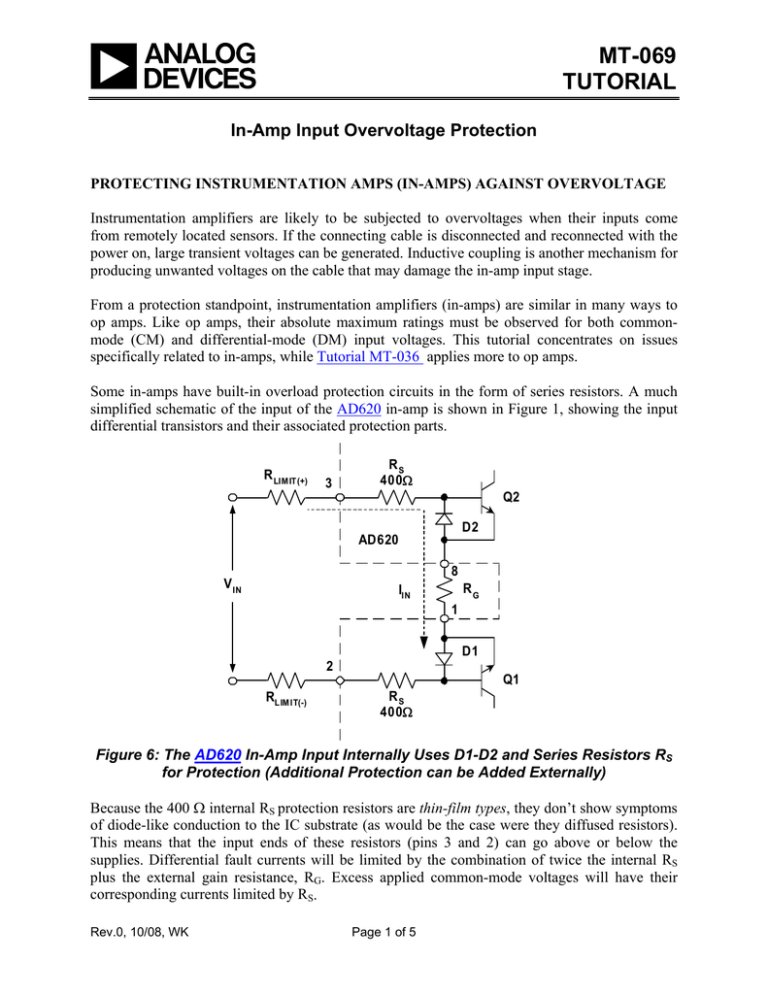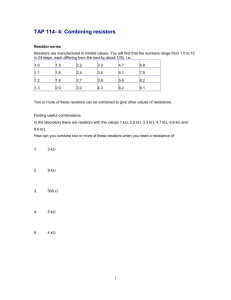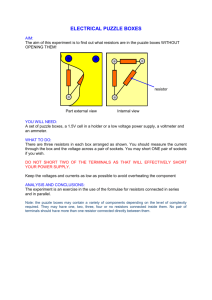MT-069 TUTORIAL In-Amp Input Overvoltage Protection
advertisement

MT-069 TUTORIAL In-Amp Input Overvoltage Protection PROTECTING INSTRUMENTATION AMPS (IN-AMPS) AGAINST OVERVOLTAGE Instrumentation amplifiers are likely to be subjected to overvoltages when their inputs come from remotely located sensors. If the connecting cable is disconnected and reconnected with the power on, large transient voltages can be generated. Inductive coupling is another mechanism for producing unwanted voltages on the cable that may damage the in-amp input stage. From a protection standpoint, instrumentation amplifiers (in-amps) are similar in many ways to op amps. Like op amps, their absolute maximum ratings must be observed for both commonmode (CM) and differential-mode (DM) input voltages. This tutorial concentrates on issues specifically related to in-amps, while Tutorial MT-036 applies more to op amps. Some in-amps have built-in overload protection circuits in the form of series resistors. A much simplified schematic of the input of the AD620 in-amp is shown in Figure 1, showing the input differential transistors and their associated protection parts. R LIM IT (+) 3 RS 400Ω Q2 D2 AD620 8 V IN RG IIN 1 D1 2 Q1 RL IM IT(-) RS 400Ω Figure 6: The AD620 In-Amp Input Internally Uses D1-D2 and Series Resistors RS for Protection (Additional Protection can be Added Externally) Because the 400 Ω internal RS protection resistors are thin-film types, they don’t show symptoms of diode-like conduction to the IC substrate (as would be the case were they diffused resistors). This means that the input ends of these resistors (pins 3 and 2) can go above or below the supplies. Differential fault currents will be limited by the combination of twice the internal RS plus the external gain resistance, RG. Excess applied common-mode voltages will have their corresponding currents limited by RS. Rev.0, 10/08, WK Page 1 of 5 MT-069 Input transistors Q1 and Q2 have protection diodes D1 and D2 across their base-emitter junctions, to prevent reverse breakdown. For differential voltages, analysis shows that a fault current, IIN, flows through the external RLIMIT resistors (if present), the internal RS resistors, the gain-setting resistor RG, and two diode drops (Q2, D1). For the AD620 topology, RG varies inversely with gain, and a worst case (lowest resistance) occurs with the maximum gain of 1000, when RG is 49.9 Ω. Therefore the lowest total internal path series resistance is about 850 Ω. For the AD620, any combination of CM and differential input voltages should be limited to levels that limit the input fault current to 20 mA, maximum. A purely differential voltage of 17 V would result in this current level, for the lowest resistance case. For CM voltages which may go beyond either rail, an internal ESD protection diode (not shown in Figure 1) conducts, effectively clamping the driven input to either +VS or –VS. For this overvoltage CM condition, the 400 Ω value of RS and the excess voltage beyond the rail determines the current level. If for example VIN is 23 V with +VS at 15 V, 8 V appears across RS, and the 20 mA current rating is reached. Higher fault voltages can be dealt with by adding the external RLIMIT resistance, to maintain fault current at 20 mA or less. However, the Johnson noise generated by the RLIMIT resistors (4 nV/√Hz @ 25°C for a 1000 Ω resistor) may limit system performance if they are too large. The maximum allowable input fault current is specified on the in-amp data sheet and can vary between devices. In addition, the data sheet generally contains a discussion of the input circuit and recommended protection methods. If additional protection is required (beyond simply adding the RLIMIT resistors as described above), a generalized external voltage protection circuit for an in-amp like the AD620 is shown in Figure 2. +V S D3 D4 R L IM IT(+) 500Ω 3 8 D1 V IN R L IM IT(-) 500Ω 7 + D2 AD620 5 1 D3 - D6 = 2 2 N3904 NC D5 V OU T 6 RG V R EF 4 D6 -V S Figure 2: A Generalized Diode Protection Circuit for the AD620 and Other In-Amps uses D3-D6 for CM Clamping and Series Resistors RLIMIT for Protection Page 2 of 5 MT-069 In this circuit, low-leakage diodes D3-D6 are used as CM clamps. Since the in-amp bias current may be only 1 nA or so (for the AD620), a low-leakage diode type is mandatory, especially for high source impedances. It is a good idea to check the diodes' specifications to ensure that their conduction begins well before the in-amps internal ESD protection diodes start drawing current. Although they provide excellent input protection, standard Schottky diodes can have leakage up to several mA. However, fast Schottky diodes, such as International Rectifier type SD101 series have 200 nA maximum leakage currents and 400 mW typical power dissipation. It should be noted that not only must the diodes have basically low leakage, they must also maintain low leakage at the highest expected temperature. This suggests either FET type diodes, or the transistor collector-base types shown. The RLIMIT resistors are chosen to limit the maximum diode current under fault conditions. If additional differential protection is used, either back-back zener or Transzorb clamps can be used, shown as D1-D2. If this is done, leakage of these diodes should be carefully considered. Many single-supply in-amps are topologically similar to the two-amplifier in-amp circuit which is shown within the dotted box of Figure 3. +VS RLIMIT + RLIMIT VOUT A2 + _ A1 R1' _ R1 V2 R2' R2 R2 2R2 G = 1 + R1 + R G VREF RG Figure 3: Single-Supply In-Amps may or may not Require External Protection in the form of Resistors and Clamp Diodes In terms of the necessity for externally added protection components, a given in-amp may or may not require them. Each case needs to be considered individually. For example, some in-amps have clamp diodes as shown, but internal to the device. The AD623 is such a part, but it lacks the series resistors, which can be added externally when and if necessary. Note that this approach Page 3 of 5 MT-069 allows the RLIMIT value to be optimized for protection, with negligible impact on noise for those applications not needing the protection. Also, some in-amp devices have both internal protection resistors and clamping diodes, an example here is the AD627. In this device, the internal protection is adequate for transients up to 40 V beyond the supplies (a 20 mA fault current in the internal resistors). For overvoltage levels higher than this, external RLIMIT resistors can be added. The use of the Schottky diodes as shown at the two inputs is an option for in-amp protection provided the source impedance is low enough so that the diode leakage current produces acceptable errors. If no clamping is specifically provided internally, then they are applicable. Note that in many cases, due to internal protection networks of modern in-amps, these diodes just won’t be necessary. But again, there aren’t hard rules on this, so always check the data sheet before finalizing an application. To summarize, Figure 4 reviews the major points of the in-circuit overvoltage issues for in-amps discussed in this section. INPUT VOLTAGES MUST NOT EXCEED ABSOLUTE MAXIMUM RATINGS (Usually Specified With Respect to Supply Voltages) Requires VIN(CM) Stay Within a Range Extending to ≤0.3V Beyond Rails (–VS – 0.3V ≥ VIN ≤ +VS + 0.3V) IC Input Stage Fault Currents Must Be Limited (< 5mA Unless Otherwise Specified) Avoid Reverse-Bias Breakdown in Input Stage Junctions! Differential and Common Mode Ratings Often Differ Some ICs Contain Internal Input Protection z Diode Voltage Clamps, Current Limiting Resistors (or both) z Absolute Maximum Ratings Must Still Be Observed No Two Amplifiers are Exactly the Same Always consult the in-amp data sheet for overvoltage protection recommendations Figure 4: A Summary of In-Amp Overvoltage Issues If these overvoltage precautions for op amps and in-amps seem complex, yes indeed, they are! Whenever op amp (or in-amp) inputs (and outputs) go outside equipment boundaries, dangerous or destructive things can happen to them. Obviously, these potentially hazardous situations should be anticipated, for highest reliability. Page 4 of 5 MT-069 Fortunately, many applications are contained entirely within the equipment, and usually see inputs and outputs to/from other ICs on the same power system. Therefore clamping and protection schemes typically aren’t necessary for these cases. REFERENCES 1. Hank Zumbahlen, Basic Linear Design, Analog Devices, 2006, ISBN: 0-915550-28-1. Also available as Linear Circuit Design Handbook, Elsevier-Newnes, 2008, ISBN-10: 0750687037, ISBN-13: 9780750687034. Chapter 2. 2. Walter G. Jung, Op Amp Applications, Analog Devices, 2002, ISBN 0-916550-26-5, Also available as Op Amp Applications Handbook, Elsevier/Newnes, 2005, ISBN 0-7506-7844-5. Chapter 2. 3. Charles Kitchin and Lew Counts, A Designer's Guide to Instrumentation Amplifiers, 3rd Edition, Analog Devices, 2006. Copyright 2009, Analog Devices, Inc. All rights reserved. Analog Devices assumes no responsibility for customer product design or the use or application of customers’ products or for any infringements of patents or rights of others which may result from Analog Devices assistance. All trademarks and logos are property of their respective holders. Information furnished by Analog Devices applications and development tools engineers is believed to be accurate and reliable, however no responsibility is assumed by Analog Devices regarding technical accuracy and topicality of the content provided in Analog Devices Tutorials. Page 5 of 5






